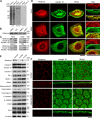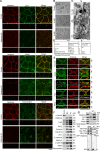The keratin-binding protein Albatross regulates polarization of epithelial cells
- PMID: 18838552
- PMCID: PMC2557036
- DOI: 10.1083/jcb.200803133
The keratin-binding protein Albatross regulates polarization of epithelial cells
Abstract
The keratin intermediate filament network is abundant in epithelial cells, but its function in the establishment and maintenance of cell polarity is unclear. Here, we show that Albatross complexes with Par3 to regulate formation of the apical junctional complex (AJC) and maintain lateral membrane identity. In nonpolarized epithelial cells, Albatross localizes with keratin filaments, whereas in polarized epithelial cells, Albatross is primarily localized in the vicinity of the AJC. Knockdown of Albatross in polarized cells causes a disappearance of key components of the AJC at cell-cell borders and keratin filament reorganization. Lateral proteins E-cadherin and desmoglein 2 were mislocalized even on the apical side. Although Albatross promotes localization of Par3 to the AJC, Par3 and ezrin are still retained at the apical surface in Albatross knockdown cells, which retain intact microvilli. Analysis of keratin-deficient epithelial cells revealed that keratins are required to stabilize the Albatross protein, thus promoting the formation of AJC. We propose that keratins and the keratin-binding protein Albatross are important for epithelial cell polarization.
Figures





Similar articles
-
PDZ-domain-directed basolateral targeting of the peripheral membrane protein FRMPD2 in epithelial cells.J Cell Sci. 2009 Sep 15;122(Pt 18):3374-84. doi: 10.1242/jcs.046854. Epub 2009 Aug 25. J Cell Sci. 2009. PMID: 19706687
-
Identification of trichoplein, a novel keratin filament-binding protein.J Cell Sci. 2005 Mar 1;118(Pt 5):1081-90. doi: 10.1242/jcs.01667. J Cell Sci. 2005. PMID: 15731013
-
Foxj1 is required for apical localization of ezrin in airway epithelial cells.J Cell Sci. 2003 Dec 15;116(Pt 24):4935-45. doi: 10.1242/jcs.00830. J Cell Sci. 2003. PMID: 14625387
-
Endocytosis of the apical junctional complex: mechanisms and possible roles in regulation of epithelial barriers.Bioessays. 2005 Apr;27(4):356-65. doi: 10.1002/bies.20203. Bioessays. 2005. PMID: 15770686 Review.
-
The challenges of abundance: epithelial junctions and small GTPase signalling.Curr Opin Cell Biol. 2005 Oct;17(5):466-74. doi: 10.1016/j.ceb.2005.08.012. Curr Opin Cell Biol. 2005. PMID: 16112561 Review.
Cited by
-
Exploring Mouse Protein Function via Multiple Approaches.PLoS One. 2016 Nov 15;11(11):e0166580. doi: 10.1371/journal.pone.0166580. eCollection 2016. PLoS One. 2016. PMID: 27846315 Free PMC article.
-
Phosphorylation and Reorganization of Keratin Networks: Implications for Carcinogenesis and Epithelial Mesenchymal Transition.Biomol Ther (Seoul). 2015 Jul;23(4):301-12. doi: 10.4062/biomolther.2015.032. Epub 2015 Jul 1. Biomol Ther (Seoul). 2015. PMID: 26157545 Free PMC article. Review.
-
Establishing and regulating the composition of cilia for signal transduction.Nat Rev Mol Cell Biol. 2019 Jul;20(7):389-405. doi: 10.1038/s41580-019-0116-4. Nat Rev Mol Cell Biol. 2019. PMID: 30948801 Free PMC article. Review.
-
Super-resolution architecture of mammalian centriole distal appendages reveals distinct blade and matrix functional components.Nat Commun. 2018 May 22;9(1):2023. doi: 10.1038/s41467-018-04469-1. Nat Commun. 2018. PMID: 29789620 Free PMC article.
-
Truncation of monocyte chemoattractant protein 1 by plasmin promotes blood-brain barrier disruption.J Cell Sci. 2011 May 1;124(Pt 9):1486-95. doi: 10.1242/jcs.082834. Epub 2011 Apr 12. J Cell Sci. 2011. PMID: 21486949 Free PMC article.
References
-
- Bornslaeger, E.A., C.M. Corcoran, T.S. Stappenbeck, and K.J. Green. 1996. Breaking the connection: displacement of the desmosomal plaque protein desmoplakin from cell-cell interfaces disrupts anchorage of intermediate filament bundles and alters intercellular junction assembly. J. Cell Biol. 134:985–1001. - PMC - PubMed
-
- Chen, X., and I.G. Macara. 2005. Par-3 controls tight junction assembly through the Rac exchange factor Tiam1. Nat. Cell Biol. 7:262–269. - PubMed
-
- Coulombe, P.A., and P. Wong. 2004. Cytoplasmic intermediate filaments revealed as dynamic and multipurpose scaffolds. Nat. Cell Biol. 6:699–706. - PubMed
-
- Fuchs, E., and D.W. Cleveland. 1998. A structural scaffolding of intermediate filaments in health and disease. Science. 279:514–519. - PubMed
Publication types
MeSH terms
Substances
Associated data
- Actions
LinkOut - more resources
Full Text Sources
Molecular Biology Databases
Miscellaneous

